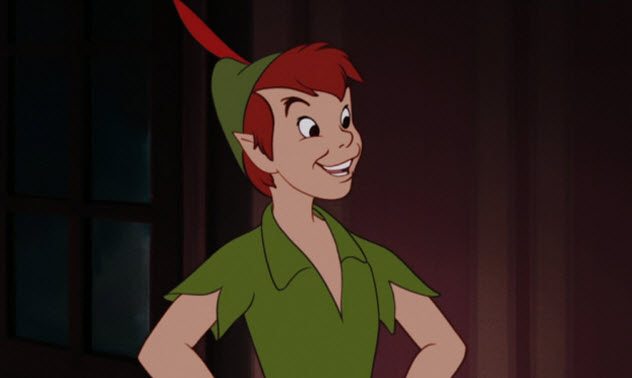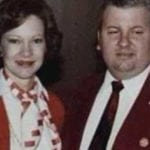 Movies and TV
Movies and TV  Movies and TV
Movies and TV  History
History 10 Things You Never Knew About Presidential First Ladies
 Movies and TV
Movies and TV 10 Zombie Movies That Will Actually Terrify You
 Humans
Humans 10 Times Scientists Were Absolutely Sure… and Absolutely Wrong
 Our World
Our World 10 Pivotal Moments for Life on Earth
 Movies and TV
Movies and TV 10 Most Realistic Medical TV Shows of All Time
 Creepy
Creepy 10 Eerie & Mysterious Ghosts of the Pacific Coast
 Weird Stuff
Weird Stuff 10 Typos That Accidentally Changed History
 History
History 10 Times Trickery Won Battles
 Technology
Technology 10 Awesome Upgrades to Common Household Items
 Movies and TV
Movies and TV 10 Movie Flops That Found Their Way to Cult Classic Status
 History
History 10 Things You Never Knew About Presidential First Ladies
 Movies and TV
Movies and TV 10 Zombie Movies That Will Actually Terrify You
Who's Behind Listverse?

Jamie Frater
Head Editor
Jamie founded Listverse due to an insatiable desire to share fascinating, obscure, and bizarre facts. He has been a guest speaker on numerous national radio and television stations and is a five time published author.
More About Us Humans
Humans 10 Times Scientists Were Absolutely Sure… and Absolutely Wrong
 Our World
Our World 10 Pivotal Moments for Life on Earth
 Movies and TV
Movies and TV 10 Most Realistic Medical TV Shows of All Time
 Creepy
Creepy 10 Eerie & Mysterious Ghosts of the Pacific Coast
 Weird Stuff
Weird Stuff 10 Typos That Accidentally Changed History
 History
History 10 Times Trickery Won Battles
 Technology
Technology 10 Awesome Upgrades to Common Household Items
10 People Stranger Than The Fictional Characters They Inspired
Stories have to be bound by logic. Life does not. Authors usually draw upon interesting personalities for inspiration. For these ten people, the writers did not do them justice. As fantastical as many of the characters in the literary canon are, they cannot compare to the absurdity of the following ten people behind notable creations.
Top 10 Mysterious People Who Should Have Movies Made About Them
10 Alfredo Balli Trevino
Thomas Harris stumbled upon his muse on accident.[1] Harris’ magazine initially deployed him to interview Monterey Prison inmate Dykes Askew Simmons. Simmons told Harris that he would have died in a botched escape attempt if not for Dr. Alfredo Balli Trevino’s generous help. As Harris questioned Trevino, the surgeon eloquently spoke on psychoanalysis’ merits. Harris, convinced Trevino was an employee, was shocked to learn that Trevino was a fellow prisoner with a gory background.
One does not inspire the most infamous criminal in history without being somewhat evil. In 1959, Trevino severed his lover Jesus Castillo Rangel’s throat with a scalpel. Trevino’s ability to navigate both educated articulacy and gruesome instincts inspired the suave cannibal turned serial killer Hannibal Lecter. For a depraved maniac, the actual Hannibal was relatively swell.
If you ignore the murder, Trevino used his surgical prowess for good. Out of prison, Trevino mostly treated elderly and poor patients. He never charged for his services. His patients commended him, “as a good guy.”[2] Trevino spent his last years tending to those who needed his help the most.
9 Daniel Ruettiger
Unlike other entries on the list, Daniel Ruettiger never had an alter ego. As the titular underdog in the 1993 biographical football movie Rudy, “Rudy” has become shorthand for anybody who strives towards their dreams no matter the obstacles. The real Rudy put up a few of those obstacles himself.
When one becomes an emblem of athletic perseverance, they can slap their name on any item remotely associated with sports. Rudy exploited this to become a con-artist. The previously pure symbol of endurance branded his image on the “Rudy Nutrition” line of sports drinks.[3] His attempt as a salesman was less triumphant than his career at Notre Dame. Failing to capture any audience, the company artificially inflated the penny stock’s value by defrauding investors with misleading statements. Allegedly, they illicitly profited $11 million.[4] The scheme was exposed in 2008. “Rudy Nutrition” went out of business shortly afterward.
8 Dennis Ketcham
Dennis Ketcham never lived the idealistic childhood of his cartoon counterpart.[5] Inspired by his son’s antics, Hank created Dennis the Menace, the mischievous scamp and eternal tormentor of neighbor Mr. Wilson. Naming his most famous creation after his child drove a wedge in the family. His mother, Alice, turned to alcohol. His father receded into his work at the expense of the same child he was depicting.
In 1959, Hank and Alice divorced. Later that year, Alice accidentally overdosed at 41. Hank coped with the loss by marrying Jo Anne Stevens. The family moved to Geneva. As Dennis struggled in Swiss boarding schools, his father sent him back to the United States. Hank stayed in Europe.
In 1966, Dennis joined the Marine Corps. After fighting in Vietnam, Dennis suffered from post-traumatic stress disorder. For the rest of his life, he meandered through menial jobs. The only time Dennis ever spoke to his father again was to ask for some of the money made off his name.
7 Ebenezer Lennox Scroggie
Charles Dickens’ most iconic character exists because he had dyslexia. In a fog, Dickens ambled about a cemetery. On Ebenezer Scroggie’s tombstone, read the inscription, “Meal Man,” referring to his career distributing milled corn. With his poor eyesight, Dickens thought it said “Mean Man.”[6] Shocked that anybody could be so callously remembered, Dickens envisioned an old curmudgeon who died unloved. Barely altering his protagonist’s name, this led to the grouchy miser Ebenezer Scrooge in A Christmas Carol.
Curiously, the real Ebenezer Scroggie was nothing like his yuletide namesake. Whereas Scrooge was a stingy prude, Scroggie was a freewheeling bachelor who scandalized his peers. Scroggie got into trouble with the Church of Scotland after impregnating a servant in a graveyard. A General Assembly of the church was forced to stop after Scroggie grabbed a countess’ butt. No wonder the Muppets did not reenact this version of the story. However, Scroggie’s biggest claim to fame was giving William Smellie the concept for a book storing all the world’s information. Smellie turned that idea into the first edition of the Encyclopedia Britannica.[7]
6 John Maher

In J. M. Barrie’s 1904 play Peter Pan, the single-minded Captain Hook is plagued by Tick-Tock the Crocodile, an omnipresent reminder of his encroaching mortality. The character is a whimsical reminder that death can come at any moment. Reverend John Maher knew this misfortune too well.
No one in the small village of Brede would have second guessed the parson. The only notable thing about the man was that he had a hook instead of a left hand. A convincing backstory of a carriage accident was good enough to deter any nagging questions. He spent his days honoring the Lord. That is until a former partner drove him insane.
The reverend lived a hidden life.[8] Before leading Sunday services, Maher was pirate captain in the West Indies with a cohort named Smith. The two had a falling out. Maher abandoned Smith on a Caribbean island. After being rescued, Smith vowed to hunt down the man who left him for dead. Ultimately, Smith confronted Maher by threatening to reveal the reverend’s secrets. Maher was driven mad with guilt. J.M. Barrie lightened this story of blackmail into the bumbling duo of Captain Hook and Smee.
10 Bizarre People Behind Everyday Words
5 Sam Sheppard
The Fugitive stresses that Dr. Richard Kimble was truly innocent. In both the 1960’s television series and the 1993 movie starring Harrison Ford, the physician desperately tried to clear his name after being wrongfully accused of murdering his wife. The real mysterious death of Marilyn Reese Sheppard, wife of neurosurgeon Sam Sheppard, is much more ambiguous. This section will not discuss whether Sheppard got away with slaying his spouse in 1954. Instead, it will focus on his life once acquitted.[9]
If one wanted to convince the public they were good husband material, it would not be the best idea to immediately marry a relative of the Nazi High Command. One week after being released from prison, Sheppard married German born Adriane Tabbenjohanns. Notably, Tabbenjohanns’ half-sister was Joseph Goebbels’ wife. Even Nazis have standards. When two of Sheppard’s patients died in surgery, Adriane divorced him.
Sheppard eased his depression with alcohol and a quixotic enterprise as a professional wrestler. Playing into his reputation, Sheppard performed for over 40 matches under the name “The Killer.” There he met his last wife, the 19-year-old daughter of his wrestling coach. It was a brief marriage. At 46, Dr. Sam Sheppard died of liver failure.
4 William Hickman
In the late 1920’s, William Hickman’s crime spree scandalized America. Hickman’s sociopathic tendencies were evident since he tortured animals as a child. Gradually, he upgraded to robbing gas stations and drug stores across the country. Along the way, he likely killed a girl in Wisconsin and his partner’s grandfather in California. His nationwide crime wave culminated in the depraved kidnapping of 12-year-old Marion Parker.[10]
Hickman ransomed prominent banker Perry Parker $1,500 for his daughter’s safe return. Despite their correspondence’s guarantees, Marion was already strangled with a towel. At the drop site, Hickman positioned the corpse to look like she was still alive. By the time the horrified father discovered Marion’s real condition, Hickman was gone.
This needlessly cruel image stuck with author Ayn Rand. Dubbing Hickman a “superman,” Rand admired that somebody could function with such little compassion.[11] Ayn Rand most directly referenced William Hickman for Danny Renaham in the 1928 novella The Little Street. To a lesser degree, Hickman’s philosophy informed staunch individualistic figures such as The Fountainhead’s industrial titan Howard Roark or Atlas Shrugged’s strong-willed John Galt. In his own demented way, Hickman certainly did whatever he wanted.
3 Robert Leroy Ripley
Robert Leroy Ripley’s name is synonymous with the surreal. His life reflected his bizarre proclivities. Famed for his “Believe It or Not!” cartoon series, Ripley traversed the world collecting oddities. Financed by newspaper magnate William Randolph Hearst, his travels to more than 200 countries netted him fascinating encounters with strange locals. He stored the relics from his adventures on his own private island. Shrunken heads, a menagerie teeming with exotic animals, and antiquities decorated his house. The centerpiece of his collection was a dried out whale penis and a particularly thorough assortment of erotica. He used those to entertain his self-described “harem” of women. He tended to have three to four live-in girlfriends at a time.[12]
Ripley found great success with the ladies despite not being conventionally attractive. The most notable trait of the balding artist was his protruding teeth. His jagged dentures made it impossible to properly pronounce some letters. In the 1930’s, the Warner Brothers’ character Egghead shared this inability. Appearing in the cartoon, “Believe It or Else” Egghead donned Ripley’s trademark suit and spats combo and repeated the catchphrase “I don’t believe it.” Egghead, a more inept hunter than his inspiration, eventually morphed into Elmer Fudd.[13]
2 Jean Ross
Fame alluded Jean Ross in life. She found it in fiction. Outside of a few movie cameos, her success as entertainer was limited to a small gig as a cabaret singer in the Weimar republic. One of the prominent political writers who saw her perform was Christopher Isherwood, who used her as the model for his 1937 novella Sally Bowles.
Transformed by multiple adaptations, Bowles one consistent trait is that she is a sexually adventurous singer of middling talent. Reworked on stage and screen, Sally Bowles is most closely associated with Liza Minnelli’s Oscar worthy portrayal in Bob Fosse’s 1972 film Cabaret. She inspired the similarly glamorous libertine Holly Golightly in Breakfast of Tiffany’s. These versions pigeonholed Ross as simpleminded.
Ross was no ditz. Fleeing Germany following the rise of Nazism, Ross became a leftist journalist for the British publication The Daily Worker.[14] Novelist George Orwell accused Ross and her husband Claud Cockburn of being secret propagandist. While Cockburn notoriously fabricated stories to promote Stalin’s regime as member of Comintern, Ross tenure as a war correspondent was marked by tales of the human loss. Embedded with Republican defenders, Ross witnessed nine aerial bombardments of the Spanish Civil War firsthand. The literary versions turned Ross into a star, but undermined her even more impressive real history as a brash investigator.
1 John Chapman
As a fixture of American folklore, the specifics surrounding Johnny Appleseed depend on the speaker. One universal feature of the pot adorned arborist’s tall tale is his communion with nature. This seemingly bizarre feature is the story’s most accurate part.
John Chapman was not motivated by an urge to promote botany. He was more infused by a mix of drunken bluster and divine calling. The apples he distributed over the Midwestern United States were planted to claim land and ferment for a stable source of booze.[15] In an alcoholic daze, he entertained local children by sticking pins in his feet and walking on hot coals. Inebriation helped him brazen into the wilderness unafraid of the natural lurkers like rattlesnakes or black bears. Nature was not always as kind. In his twenties, Chapman removed a chunk of his brain after a horse kicked him in the head
This lobotomized state might explain how he started talking to angels. Along with each bundle of apples, Chapman carried the message of the Church of Swedenborg. Like founder Emanuel Swedenborg, Chapman remained celibate, except for having what he called “spiritual intercourse” with angels.[16] Disney cut the part when Johnny Appleseed has drunken sex with ghosts.
10 New Facts About Famous People And Places
About The Author: The greatest fictional character Nate Yungman ever wrote was his social media persona. If you want to read more of his thoughts, you can follow him on Twitter, @nateyungman. If you had a question or comment, you can send him an email at [email protected].








